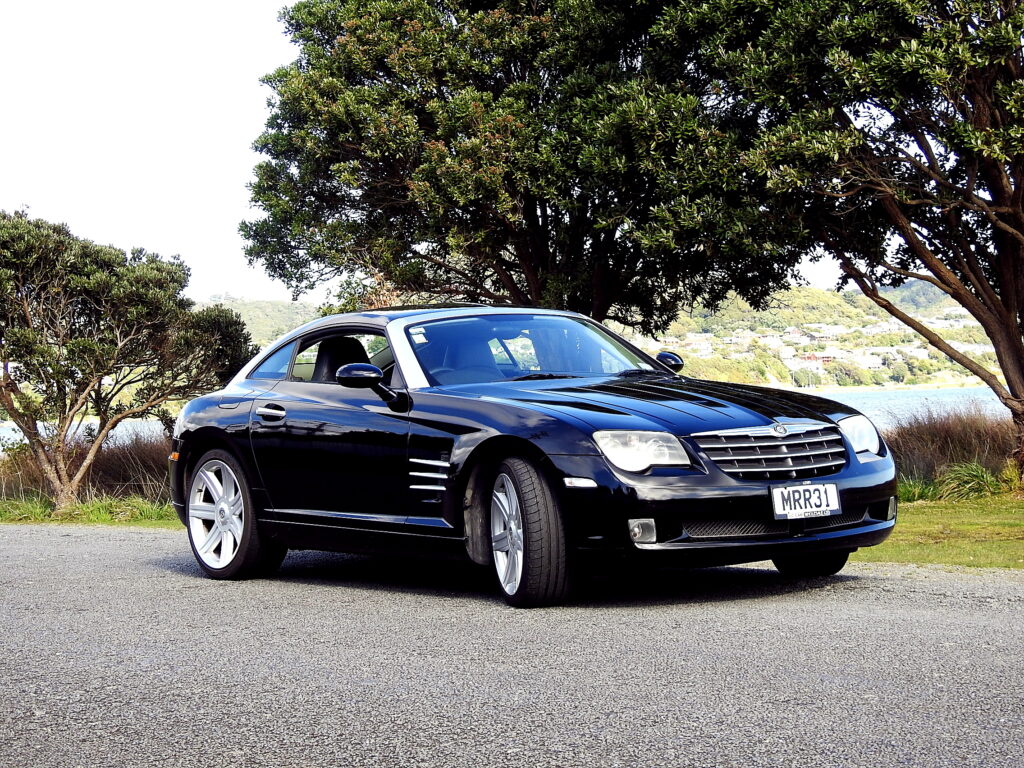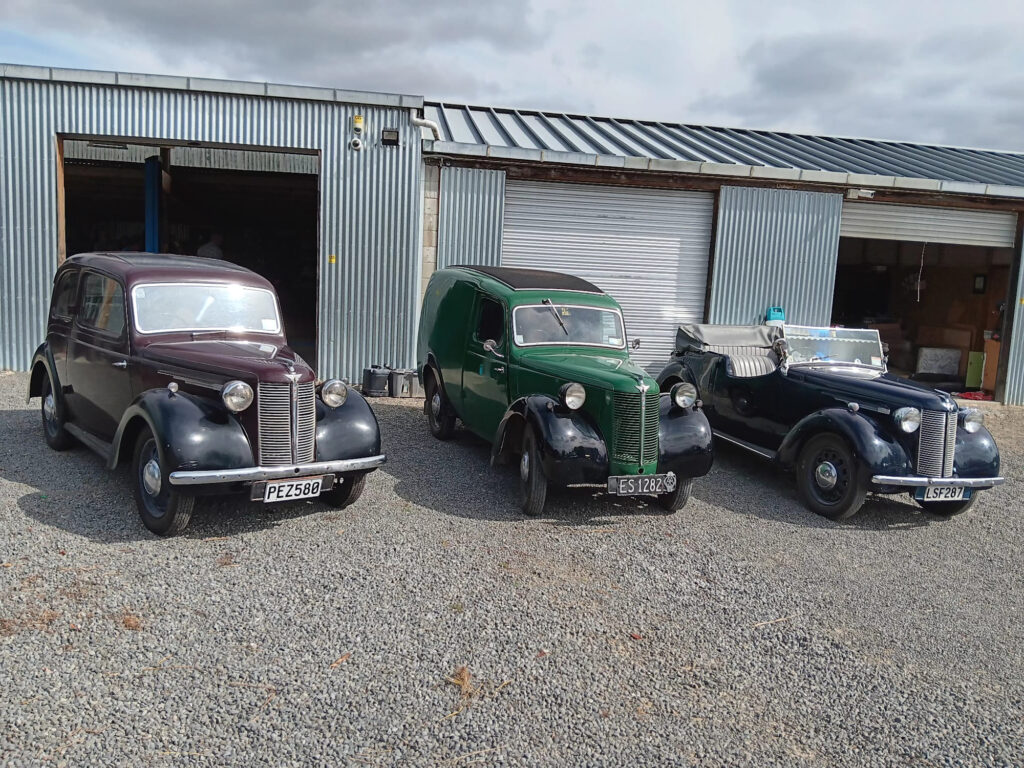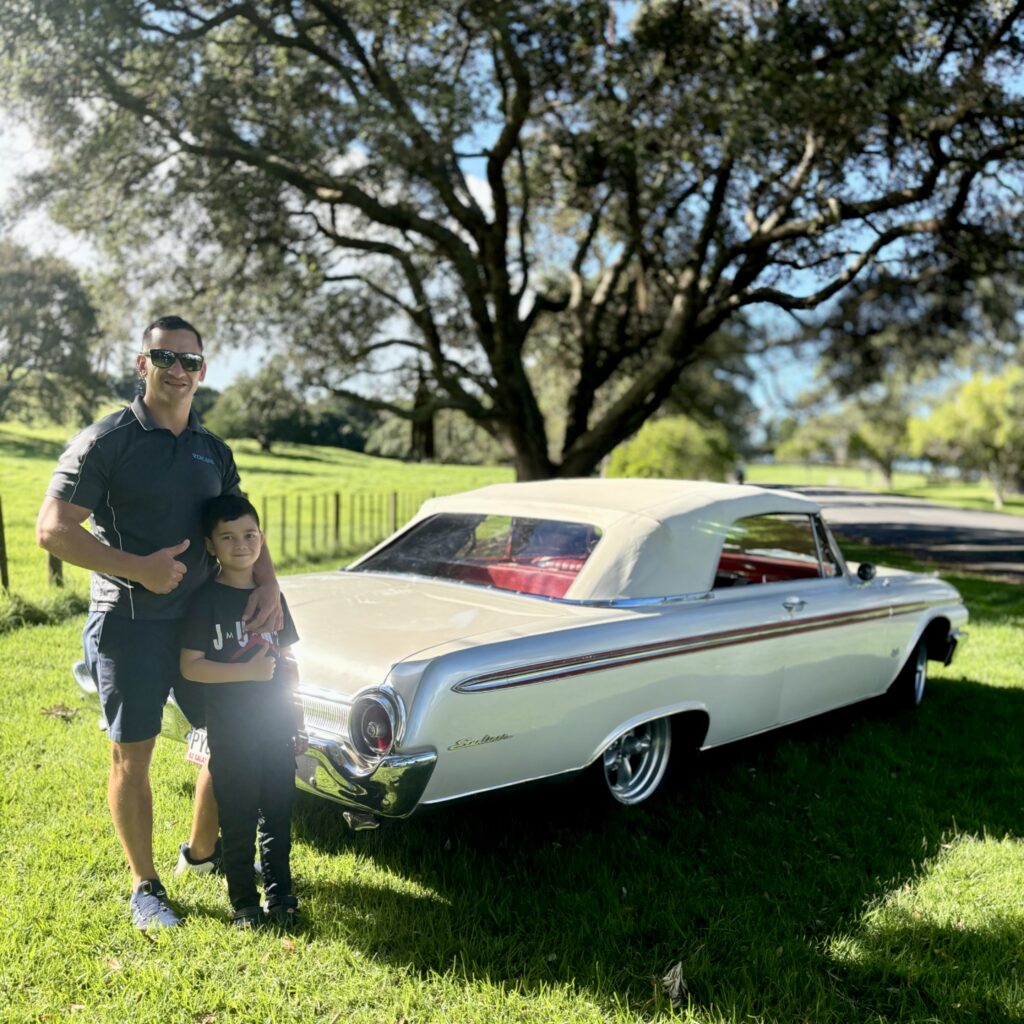Big brash and beautiful
Faced with the possibility of scrapping his cherished 1973 Ford Falcon XA GT 351 Hardtop, David Chase took the plunge, delivering it into skilled hands at Matamata Panelworks. It’s now a stunning classic and 2023 Ellerslie Intermarque Concours Masters Class winner.
This big Aussie brute of a car is our stunning cover car for this issue and the restoration journey of this classic is a fascinating tale with a jaw dropping result.
“Rarely do these Ford Falcon 351 GT hardtops last long in their original state as they are either modified, raced, or rust results in them being scrapped. They are already a rare sight on New Zealand roads and survivors turning up at car shows are well-restored as their values skyrocket past the A$200,000 mark. This is especially the case with David’s car, for a particular reason.
“Surprisingly, it’s an all matching numbers car. Yep, that’s pretty cool. A lot of them lost their motors early on, but mine’s still matching so that’s pretty good and I’m very happy about that.”
With a restoration bill approaching the $200K mark, David is thrilled to see a recent valuation well in excess of the figure.”
To purchase a copy of this issue of the magazine head here to our online shop, magstore.nz

A New Zealand automotive legend: Sir Colin Giltrap 1940-2024
The remarkable automotive career of Sir Colin Giltrap is traced by Donn Anderson, who first met him in the 1960s. New Zealand not only lost a car trader supreme with the passing of Sir Colin Giltrap in April, but he will be best remembered by the many drivers whose careers he fostered as a dedicated motor sport supporter and generous philanthropist.
“Motor racing was an early interest with Colin, a pit crew member for the late Tony Shelly at the 1962 New Zealand Grand Prix at Ardmore. One of the first cars he imported from Britain was Bruce McLaren’s Jaguar E-Type soft-top, and it was totally appropriate for Giltrap to open the McLaren Auckland dealership many years later. In 1963 a 23-year-old Giltrap raced a Volvo 122S with the talented Jim Palmer in the Wills Six-Hour production saloon car event at Pukekohe, resulting in fifth overall and second in class.”

1966 Singer Vogue
Kickstarting the next generation
A good hobby brings zest and colour to life and it can be said ‘a hobby a day keeps the doldrums away’. For Samuel Shortall, this couldn’t be truer. In the colourful world of classic motoring, his zest is an exquisite 1966 Singer Vogue, yet this match made in heaven is a little different than most readers would expect.
“After Samuel decided he wanted to get his toes wet in the classic scene, the hunt began for the perfect first car. With dad Andrew’s assistance, they set out to find something that was affordable, and also in a condition that would encourage Samuel’s passion, not a full nut and bolt restoration that would see him run for the hills. Initially Samuel had two prerequisites; either it had to be a MGB, or it needed to have four doors. After hours of looking through the offerings on the internet Samuel’s eyes lit up. “There it was,” Samuel exclaims.”

1961 Ferrari 250 GT SWB Competizione – Revival
Revival masterpiece
Few sports cars possess the ability to be both a superb open-road tourer and a hard-edged endurance racing car. Ferrari’s iconic 250 GT SWB Competizione is such a car. Capable of stunning performance and clothed in one of Pininfarina’s most memorable body designs, crafted by the master, Carrozzerie Scaglietti.
“In Richard’s view, the Ferrari 250 SWB Competizione, is the most sought after of Ferraris, as he explains.
“The Ferrari 250 SWB Competizione is the most desirable Ferrari of all time and the ultimate example of form following function.”
The reality of Ferrari back in the day is of a company making small production runs. Just 45 Competizione models were made out of a total production run of 167 cars, including 20 SEFAC (Scuderia Enzo Ferrari Racing Corsa) modified cars and 100 ‘Lusso” (higher comfort / race looks) models.
After considering various sources, Richard decided to approach the acknowledged best in the business, Dutch, engineer, fellow Ferrari enthusiast and racer, Alwin Hietbrink of Hietbrink Coachbuilding.
“I visited Alwin Hietbrink at his workshop in Haaksbergen in the Netherlands. He’s internationally-known, and he’s a very clever man. When I was there, the Ferrari 250 GT ‘Breadvan’ was in his workshop being rebuilt; totalled in the front, but he had completely rebuilt it.”

Ford Falcon book reviews
The essential guides to two Australian iconic muscle cars could be yours with these two rare books. One on the Ford Falcon, XA GTHO/4 and another on the Ford Falcon 1987 XC Cobra. Both of these books have been written by respected Ford Falcon collector and historian Ross Vasse. Both these titles give the complete history of these models and can be purchased directly from the author.
“More than 50 years on, the real truth behind the ill-fated Falcon XA GTHO Phase 4 is being commemorated in an expansive new book that tells the complete untold story about what really happened behind the scenes, and what the Ford Motor Company did to cover it up, by sending more Falcon GTs to New Zealand!”

1969 Ford Bronco Sport
Taming the wild horse
Ford’s evergreen off-roader, the Bronco, is enjoying a surge in popularity and values in the US as outdoor enthusiasts once again appreciate its rugged good looks, simplicity of design, and an ability to cut it when the going gets tough
“Gary McNeill encountered his first Bronco 35 years ago when he and a friend spotted this unusual four-wheel drive cruising a Dunedin street.
“A friend and I were chasing it while it was being driven to see what it was. We thought it was absolutely cool. We thought ah, this is a bit different. We found out later that it was a Bronco, and ever since then I’ve had a soft spot for them.”
Just as Covid struck, Gary spotted a Bronco advertised for sale and, despite the poor quality photos, he decided it was worth a drive north for a look.”

1970 LC Holden Torana GTR-XU-1
Good things take time
A chance visit to the Falcon and /Fairlane Car Club of Christchurch’s annual car show in Hanmer in 2023 found me taking pictures of one of my favourite cars, a bright orange Holden Torana GTR-XU1.
“Wayne’s Torana hit the streets as an LC GTR in 1970, and has since undergone several attempts to improve its performance. Starting in Auckland around 2007, its conversion to an XU-1 began by replacing its 186 ci straight six engine with a 202 from an LJ GTR-XU1. A lightened flywheel and modified 9-port head with its inlet pedestals removed. According to a 2016 ‘Out The Back’ article about it and information from then owner Ivor Borland in the Marlborough Midweek, it had “YellowTerra valves and adjustable roller-rockers, race-tuned extractors, HEI (Hot-Spark Electronic Ignition) similar to the aftermarket ones run on most V8s. The Torana now runs triple 45 DCOE Webers, and it originally had 150 Strombergs.” Performance issues followed until a loose screw from one of the carburettors was found “sitting on top of a piston!”

Looking Back: North Shore – Part 1
An automotive/racing history of my north shore bays home patch in the ’60s to ’80s By Gerard Richards
North Shore Bays was the new frontier of Auckland’s frenzied baby boomer population explosion, in the 1950s and 60s. Returned servicemen and their brides were beating a path from old town Auckland across the new harbour bridge, to the endless bays and open spaces of the North Shore.
“If we needed anything to get our red-blooded male testosterone charged for all things racing, this sealed it for us. This deadly drug consumed the somewhat unholy alliance of myself and best mates Chris Davison and Kevin Jose, resulting in us unleashing our energies racing anything that entered our radar. This included push bikes, trolleys, slot cars, model powerboats, skimboards, surfing, control line aircraft – you name it, we probably raced it.”

Postcard from America #2
Spruced up!
For my second Postcard from America, I have chosen an aeronautical theme, which I’m sure is a shared interest for many car enthusiasts. The USA has many amazing plane museums, many centred around the military history of planes.
“Notable aviation museums include the Pima Air and Space Museum in Tucson, which has an adjacent aeroplane graveyard with over 4000 planes in storage, and the National Air Force Museum in Dayton, Ohio, home of the Wright Brothers. It also features the Bockscar B29 which dropped the second ever atomic bomb used in war, on Nagasaki. There is of course the Steven F Udvar-Hazy Centre, part of the Smithsonian Institute, at Dulles Airport, Virginia, near Washington DC, which has a SR71, a Concorde, Space Shuttle Discovery and the Enola Gay, the bomber which dropped the first A-bomb, on Hiroshima.”

1951 Allard P1
The mother of all cobras
Famed designer, racing enthusiast, and one of the earliest drag racing exponents in the UK, Sydney Allard was a pioneer in the field of amalgamating a big American V8 into a nimble British sports chassis; a trend followed by Shelby, Jensen, Bristol and the Rootes Group.
“The Allard is by no means Dan’s only classic. In fact, it isn’t even his only Allard. His large, professionally equipped garage also contains a ’52 Palm Beach roadster waiting for Dan’s skilled and loving care. He apprenticed as a panel beater as a lad, and for many years he owned an engine reconditioning works in Auckland. When he retired he had unfinished business to attend to: restoring to show quality some of the classic cars he had always wanted.”

Chrysler Crossfire
An emerging classic
If I were to ask what was the first right-hand-drive North American sports car to be sold in this country, most would come up with the Ford Mustang that was launched in 2015, followed more recently by the C8 Corvette.
“Before this, it was commonly held that any right-hand-drive North American sports car had been built in a left-hand-drive configuration and then converted to right-hand drive. The car that features in our story appeared eleven years before the 2015 right-hand-drive Mustang. The Chrysler Crossfire was actually manufactured straight from the factory in right-hand-drive configuration, and it was sold in New Zealand as a new vehicle”

Kits & Pieces: The Westfield SE
The full driving experience
A self-built car means there are no restricting traditions to observe and engines can be swapped easily in a Westfield, the chassis accepting anything from a motorcycle engine to a Rover V8.
“This car started its life in Wales in 1992. Westfield sold their cars in a range of ways, the most popular being as a kit in a box with all the components required to assemble the car, except for the engine and transmission. This ‘Westie’ was a relatively quick build and on the road in 1993. It changed hands two or three times before Phill purchased it in September 1999, with only 4000 miles (7,000km) on the clock.”

Motor Sport Flashback
The end of an era
The impact of the legacy of the late Sir Colin Giltrap, was plain to see once we walked into a former supermarket in Brownsburg, about a thirty-minute drive north-west of downtown Indianapolis.
“I always think back to 2014 and a curtain-raising GP3 race on the morning of the Hungarian Grand Prix. That day, another Tauranga lad was starring when Richie Stanaway won from pole and, as the camera panned once the rostrum winners had alighted, there was Sir Colin.
It would have been an early start for him, but he confirmed when I spoke to him by phone a few days later, that it had all been worthwhile. No chest-beating; no trace of ‘we did it!’ Just the quiet satisfaction that here was another talented Kiwi on a pathway.”

Marketplace Report – Ferrari Mondial
Ferrari for the world
Built as a direct successor to the Dino 308 GT4, the Mondial signalled Ferrari’s return to the practical and relatively inexpensive mid-engine V8 2+2 layout
“Production of the Mondial lasted from 1980 to 1993 with a hefty 6800 units, more than any Ferrari before it. However, for much of its life, the Mondial has been in the shadows of the more flamboyant prancing horses of the period, like the Testarossa and 308/328 series.
The first Mondial, the Mondial 8, was criticised for being not ‘Ferrari-like’ when it came to its power output of 157kW, top speed of 220 kph and US spec cars taking 10 seconds to reach 100kph.”

Price On
Vehicle Ownership: “A bureaucratic blunder that’ll cost millions in legal fees”
“Why are ownership papers an issue now, I hear you ask? Well, some of you may have noticed friends, family or acquaintances dropping dead suddenly. Sad, or course, but if they had any of their vehicles in what was once called ‘joint ownership’, there could be more grief on the way.”
Letters to the editor
We have a couple of very interesting letters this issue, asking for info on some Kiwi cars
“I’ve recently bought a March 1958, Land Rover Series 2, that was exported to NZ arriving, according to my ‘That Car’ printout, in 1961. It then seems to disappear for 20 years, reappearing in 1981, with registration number JO1298. It then had nine owners of varying lengths of time until it was sent back to the UK a couple of years ago.”
And: Ngaio marsh’s missing jaguar
“It’s a mystery, something like one of the noted author’s stories.”



Behind the Garage Door – Austin 8 survivor story
It is not often you come across a complete set of cars, and if you do, it is highly unlikely to be a set of Austin 8s.
Show Stoppers – ALMAC Cars
Getting the story is often the easy bit; the photoshoot not so much.


Industry Insider
Where eagles dare – Eagle Automotive ltd
Traditionally going back centuries, people in Britain travelled down the left side of roads and paths, due to predominantly right-handed knights being able to draw their sword and have it closer to the opponent coming towards them on their right.
“Willie and racing buddy Ian Scott started a new company called Eagle Automotive Ltd. They started refurbishing classic V8s, often with a little more power than they entered the world with, and they started experimenting with converting left-hand-drive vehicles to right-hand-drive. A few years later, Ian and Willie’s partnership dissolved, Ian concentrating on classic cars while Willie specialised in right-hand-drive conversions. Over the last 30 or more years he and his team have converted more than 4500 vehicles. They have now come full circle with restoration and modification of classic cars back on the menu.“

Classic News
Rallies, events, shows and more…
Tony Quinn Foundation partners with driver education programme street smart
Canterbury and Otago Rally reports
Who won the Classic Cover Insurance 1962 Ford Galaxie Sunliner customer prize?
National Jaguar and Ferrari rally reports
To purchase a copy of this issue of the magazine head here to our online shop, magstore.nz








